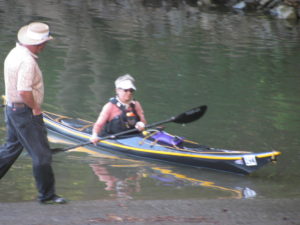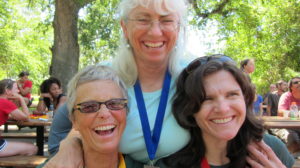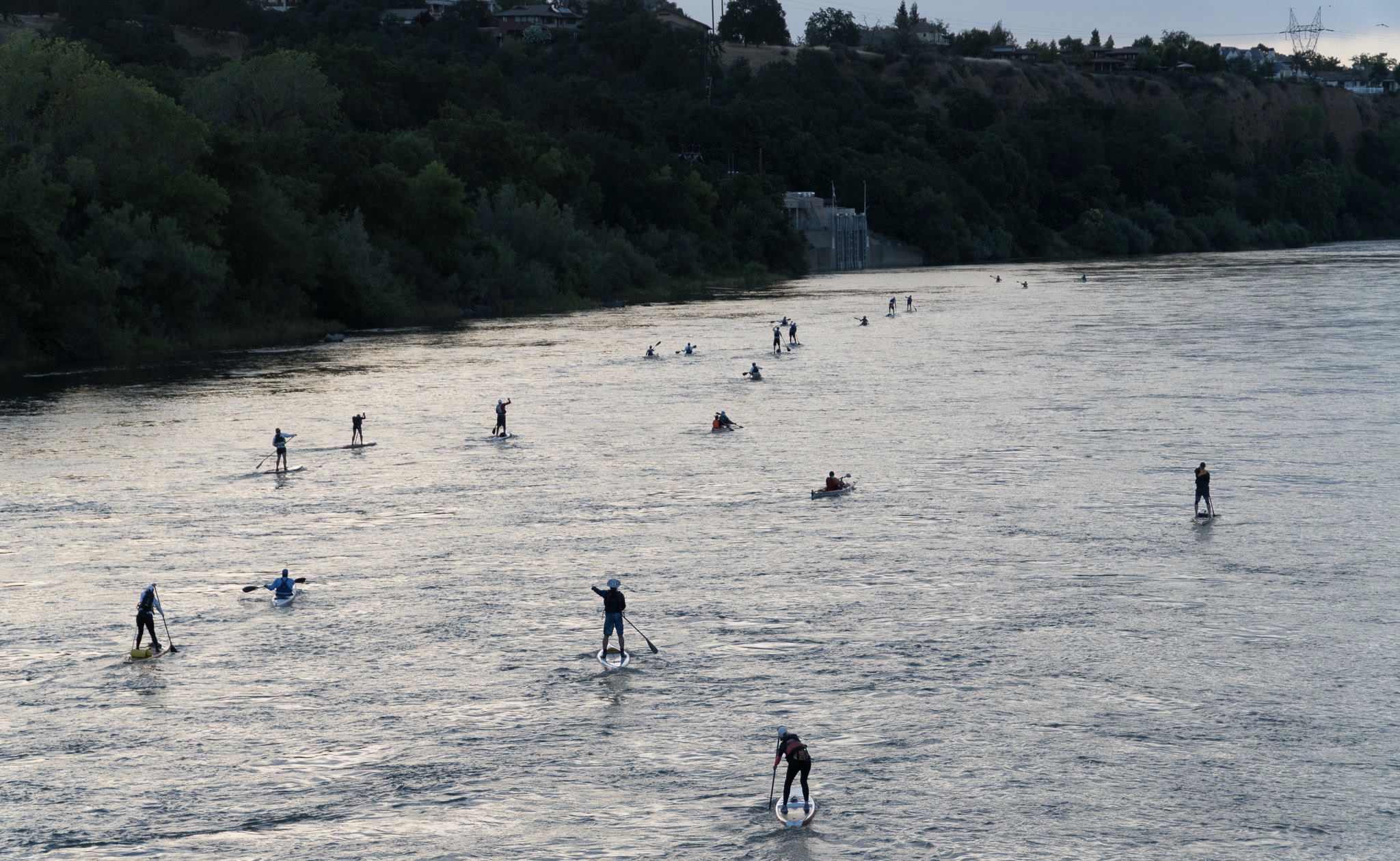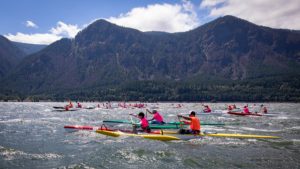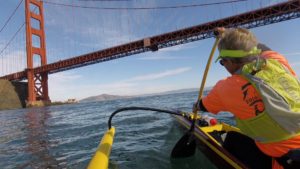Below is an article I wrote, published in Sea Kayaker Magazine in October 2013. This 100 mile paddle race, will be hosted again in 2019 under a new name, the California River Quest. For me, the past five years have been a huge learning curve in training for paddle endurance races. The keys to improvement and progress are to be consistent, set goals and keep it fun.
Introduction
The California 100, California’s first paddle sport ultramarathon, is a 100-mile paddling race on the Sacramento River from Redding to a takeout near Chico. For me, the journey began well before the starting gun sounded on Saturday morning, May 25, 2013. The training and preparations necessary for such a race require intense focus and discipline. As an outdoor professional, I’d been a guide and instructor and had a long history of outdoor pursuits that include climbing Himalayan peaks, Nordic ski marathons, river trips and an extensive résumé of sea kayak expeditions. I felt well suited for an endurance race.
During the winter months I trained regularly with core strength and cardio workouts and logged 400 paddling miles in preparation for the upcoming outrigger canoe race season. I also did a nine-day solo paddling trip in Baja in April and covered 110 miles in a loaded expedition sea kayak.
A week after I returned from Baja, I attended one of the Cal 100 pre- race clinics led by Carter Johnson, an expert ultradistance paddler. I was quite surprised and comforted to see that most of the clinic attendees were women, many of whom were established local surf-ski competitors. Everyone’s boat was longer and faster than mine; even those in sea kayaks had 19-foot boats. When we hit the water for interval training, I had to work hard just to stay near the back of the pack. I started to feel insecure about my short, sixteen-foot sea kayak; it was designed for ocean rough- water paddling and not for speed. I had no illusions about winning. I signed up for this race as a personal challenge and entered the race in the Adventure Class, not the Competitive Class.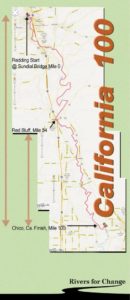
At the pre-race clinic, I reconnected with other local sea kayakers, among them Liz Hymans, a pioneer—the first woman to work as a Grand Canyon guide. She planned to paddle the last 50 miles of the racecourse, from Red Bluff to Chico, but needed someone to accompany her in her tandem. Gregg Berman, her paddling partner, was unavailable for that training run. I volunteered to fill in. The day after the clinic we put on the river by 10 A.M., just below the Red Bluff Diversion Dam.
The lower half of the racecourse was very friendly, a wide and winding lazy river with slow-moving current. We calculated it would take us between six and seven hours to arrive at our take-out near Chico. I was grateful to have Liz steering us downriver. I knew I’d have to work hard on race day to make good time covering these miles in my short sea kayak.
Two weeks later, I returned to paddle the upper section of the course, the more technical section with Class-2 rapids. Amy Byer, another woman I’d met at a pre-race clinic, paddled the section with me. Amy and I had been interval training together and she’s a very strong and technical paddler. A three-time Yukon River Quest competitor, she always kicked my butt in her 19-foot by 20-inch Kevlar sea kayak during our recent interval training on the bay. I expected she’d beat me easily in the Cal 100, though our different kayak designs landed us in separate classes for the race.
Upon our arrival in Redding, Amy and I met up with Jason Montelongo, a local paddler who knew the river well. He was also training for the Cal 100 and would be paddling a coed tandem in the competitive division. We launched and the current quickly swept us toward the Sundial Bridge. I was in my sea kayak, and with the increased river flow, the current was moving me along at a speedy clip. Once I relaxed, the short rapids provided fun wave trains and kept me focused. I had enough river paddling experience to read the water and work with the waves to my advantage. I quickly appreciated my sea kayak design as an ocean playboat and skipped along contently, but once we were back in the flat water, I worked hard to keep up.
After a long stretch of flat water, I looked forward to China Rapids, the most technical section of the racecourse, to break the monotony. We began to paddle through whirlpools where the river narrowed. I could see a gradual drop ahead but not any real white water. The water moved quickly with the high river level, but the rapids were inundated. The whirlpools intensified and challenged me to keep the bow pointed downriver and to stay upright. I paddled hard through the continuous eddies to avoid being grabbed and flipped. Amy and Jason lagged behind me, but not for long. I noticed Amy had been paddling the rapids timidly, slowing herself down. She didn’t have the powerful style I’d seen when she was paddling on the familiar waters of San Francisco Bay. She and Jason passed me during the next 15 miles of flat water. We arrived at Red Bluff, a city about halfway between Redding and Chico, having covered 55 miles in seven hours.
Race Check-In
By race day I felt ready, mentally and physically. I’d paddled the entire race- course and returned one more time to review a few shortcuts along the initial 15 miles. I’d maintained my cross-train- ing routine and kept up interval training. I had a plan for food, hydration and self- care. I believed I could finish the race in between 12 and 13 hours.
On the evening before the race I attended a safety briefing, and afterward I finalized my food prep. I was a little obsessed with food. I don’t like sweets but I had to have lots of calories. I had made a variety of bite-sized snack items: quinoa-bacon protein muffins, salted boiled potatoes with olive oil, and peanut butter and banana sandwiches. I tested some ready-made performance foods and found I could stomach Stingers and one kind of protein bar. I decided on the food I would carry and packed it for checkpoints. My partner, Andrea, would bring the packages of food to me at two of three checkpoints. We went over her role at the checkpoints so that my stop time would be used efficiently.
The start time for the Adventure Class was 6 A.M., an hour earlier than the Competitive Class race start. As I paddled across the river to the start line, I was pleased to see the current had picked up because of a dam release just above Redding. The weather forecast called for reasonable temperatures in the high 70s, a blessing since it can hit the 90s in May.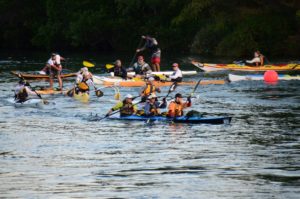
The wait at the start line was nerve- racking as we all grouped up inside the eddyline to keep out of the current and brace for the sound of the starting gun. My strategy was to avoid the bunching up at the start buoy upstream and stay slightly upstream of the pack to avoid collisions. The gun went off and I rounded the start buoy and headed downriver. I kept my eye on John Dye, one of the top contenders in the Adventure Class, and followed his line to the Sundial Bridge. There I peeled off to river right and caught my first sneaky shortcut line. Nobody followed me. I picked up speed, relaxed and found my rhythm. As I reentered the main channel, to my surprise, I was ahead of the pack, even ahead of John. He quickly caught up, commented that he wished he’d have followed me and then passed me by. The second shortcut came up fast and John and a few others preceded me through the wave train and sped ahead. 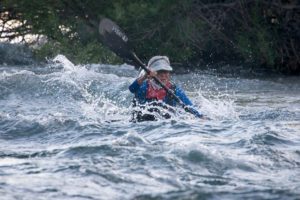
I double-checked the laminated river race map I had tucked under my deck bungees. The third shortcut was com-ing up, but I had seen a paddler capsize on the corner a week ago, so I bypassed it and took a more conservative line. Everyone who took the shortcut dis- tanced themselves from me. The cur- rents merged where the river took an abrupt bend to the left. I just didn’t want to risk getting caught up there with other boaters. I quickly made peace with my decision and refocused on paddling efficiently— engaging my abs, relaxing my shoulders, maintaining good posture and smiling.
Checkpoint One
The two shortcuts I took helped me stay near the front of the pack for the first 20 miles. I knew I was on target for my per-sonal goal as I arrived at the first check- point at 8:43 A.M. The checkpoint was a hub of activity. John Dye was leaving as I arrived. I glided into shore where a volunteer quickly assisted me.
Once I regained function in my legs, I sauntered off to register my number at the checkpoint and take a quick pee. I drank the last of my protein smoothie. Ten minutes quickly went by. My friend Matt Palmariello, racing on a stand-up paddle board, had come and gone in a few minutes. I quickly got into my boat. I trailed Steph Siaris and Samantha Pinney, who paddled a tandem outrigger, and I kept them in sight for a few more miles before they disappeared. Liz and Gregg, paddling their tandem kayak in the Adventure Class, were slightly ahead of me. About an hour into this second leg, I started seeing paddlers from the Competitive Class making up the staggered start. Most of these fast paddlers were using surfskis. As they sped by me, I passed Matt on his paddle board. We exchanged a few friendly words but both returned to our focus. I frequently glanced at the GPS on my deck, tracking my mileage and speed for a good diver- sion. It also helped me find the faster moving water. I knew China Rapids were coming soon. One other sea kayaker, No. 196, was tailing me just before China Rapids. We exchanged greetings and he mentioned he had just capsized from a 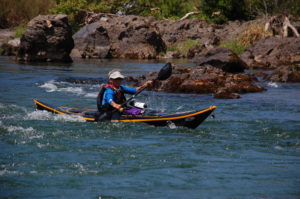 strong whirlpool. I asked if he had paddled China Rapids before and he replied that he hadn’t. I shared my strategy for paddling through the strong whirlpools. I was a little worried that he would pull in front of me before the rapids, capsize and slow me down. He was grateful for my advice and humbly said he would follow me down China Rapids. The familiar lava formations began to appear and the whirlpools intensified. I stayed relaxed and loose as I powered up to paddle through the whirlpools, picking up speeds of up to 12 miles per hour for just a few minutes. After the rapids, I went back to my rhythm for flatter water and kept Liz and Gregg ahead in sight until Checkpoint Two.
strong whirlpool. I asked if he had paddled China Rapids before and he replied that he hadn’t. I shared my strategy for paddling through the strong whirlpools. I was a little worried that he would pull in front of me before the rapids, capsize and slow me down. He was grateful for my advice and humbly said he would follow me down China Rapids. The familiar lava formations began to appear and the whirlpools intensified. I stayed relaxed and loose as I powered up to paddle through the whirlpools, picking up speeds of up to 12 miles per hour for just a few minutes. After the rapids, I went back to my rhythm for flatter water and kept Liz and Gregg ahead in sight until Checkpoint Two.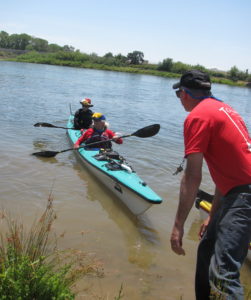
Checkpoint Two
I arrived at the second checkpoint at 12:40 P.M. I was still making good time 55 miles into the race. Andrea filled my the hydration bladder clipped onto my fore- deck. I didn’t have an appetite but knew I needed the calories, so I forced down a couple quinoa protein muffins and stuffed a peanut butter-banana sandwich in the pocket of my PFD. I hopped back in my kayak and pushed off. I figured I would eat while I was back on the river. After passing the Red Bluff Diversion Dam, I just floated along and ate my pocketed PB-banana bites and a few bites of a protein bar. I had a headache, so I rehydrated. I knew I would lose steam if I didn’t refuel and stay hydrated. I could feel my hands getting a little sore so I put on my thin fingerless gloves to avoid blisters. I had outfitted my seat with a thin nylon pad velcroed in place to prevent chafing. I also lathered up with diaper rash cream before race start. I was hold- ing up well and just needed to take care of the basics—food and water.
The third leg of the race was 25 miles, the longest stretch, with transitions from fun little rapids to flat water and slower-moving current. In my short boat I had to work hard for the miles. My left shoulder ached so I popped a couple of Aleves. I stopped paddling every hour to stretch and rest for just a few minutes. The pain would ease up and I’d recover enough for another hour of paddling. I was very familiar with pain manage- ment from my years of mountaineering, where suffering comes with the sport. I have also lived with rheumatoid arthritis for 30 years. I checked myself from head to toe to bring awareness to my paddling technique and how I was using my body: good sitting posture, relaxed shoulders, engaged abs, rotating, keeping the catch upfront and hands low. For most of the race, I had been trailing No. 126, a woman paddling a surfski equipped with a gull wing—small outriggers to add stability to an otherwise tippy vessel. I tried to get ahead of her, more as a distraction from the monotony of the lazy river than a competitive impulse, but I just didn’t have it in me to pass her. At every river bend, I hoped to see that Woodson Bridge checkpoint. There was still no sign of Amy.
Checkpoint Three
At the end of 82 miles I was relieved to land at the third and last checkpoint. I arrived at 4:09 P.M., still making good time. I was grateful to see Andrea along the riverside beach. She offered potatoes, protein muffins and the complete menu that I had prepared the night before. I still had no appetite, and felt a bit nauseated just at the thought of food. I stashed an- other peanut butter–banana bite into my pocket to eat later. I saw Liz and Gregg take off just as I arrived. I performed my checkpoint routine efficiently so as to waste no time and get on the water to complete the final 18 miles. The pack had become quite spread out. A light afternoon wind started to blow upriver, but I plugged away without much notice of the wind. Paddling San Francisco Bay had inured me to headwinds. I finally managed to pull ahead of the woman in the surfski, No. 126. She appeared competitive with me, and earlier had play- fully gloated that she’d kept her lead on me thus far in the race. I smiled as I drew even with her and we had a friendly exchange about the wind. I pulled ahead of her and maintained my pace and focus as the next few miles passed by.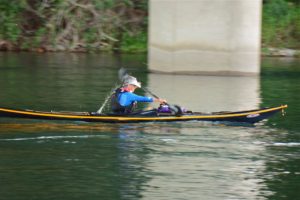
For a while I couldn’t see anyone behind or ahead of me, then I heard music playing and the sound of conversation in the distance behind me. As I stopped for a short break, two surfski paddlers passed me, chatting away as though on a leisure paddle. One of the paddlers had a music system mounted on his deck. I had been in my zone for so long, I didn’t have the energy to muster a conversation with anyone. They sped along ahead and became a speck before disappearing around the river bend. The river straightened out and I could see the two paddle boarders, just black and white dots in the distance, battling it out. I was on the home stretch.
The Finish
I recognized the finish from afar. I could see the bridge and a small crowd gathered on the riverbank above looking down for racers making their final strokes to the finish. I powered up to finish strong and smiled as I crossed that finish line at 6:47P.M. Carter’s voice resounded through the bullhorn and cheers came from above. I exited my boat and volunteers helped carry my boat up to the grass. I had met my goal and completed the 100- mile race in 12 hours, 47 minutes and 8 seconds. I took first place in the women’s Adventure Kayak solo division. Overall, in the Adventure Kayak solo division, I placed third. I cheered for Amy as she finished in 13 hours, 13 minutes and 31 seconds. We hugged in celebration of our accomplishment, and she complimented me on taking advantage of the short- cuts and the rapids and managing my time at the checkpoints. “You paddled a smart race,” she said.
Check out my other posts on training and paddle races, Ocean Inspired: Training Tips, Motivation Tips for an Active Life, and An Epic Odyssey: Part 1.
Photo credits: Tom Gomes, Lisa Thomas, Rivers For Change, Carter Johnson
